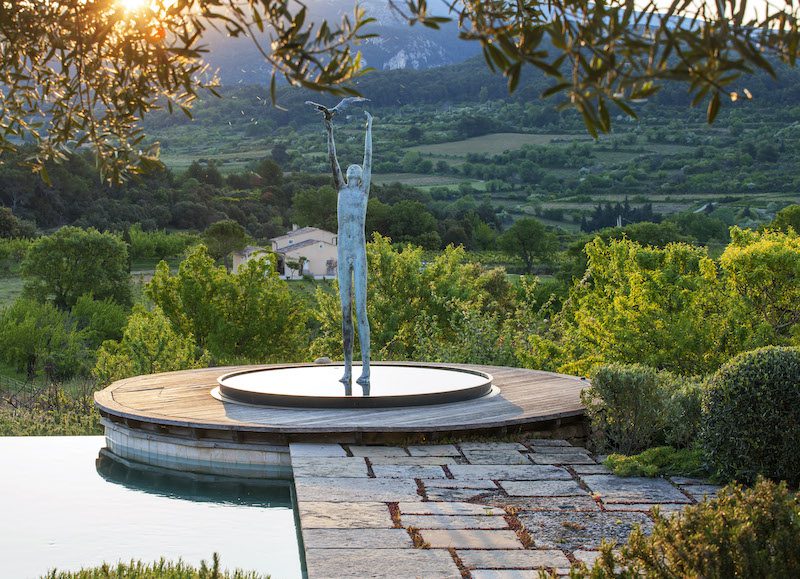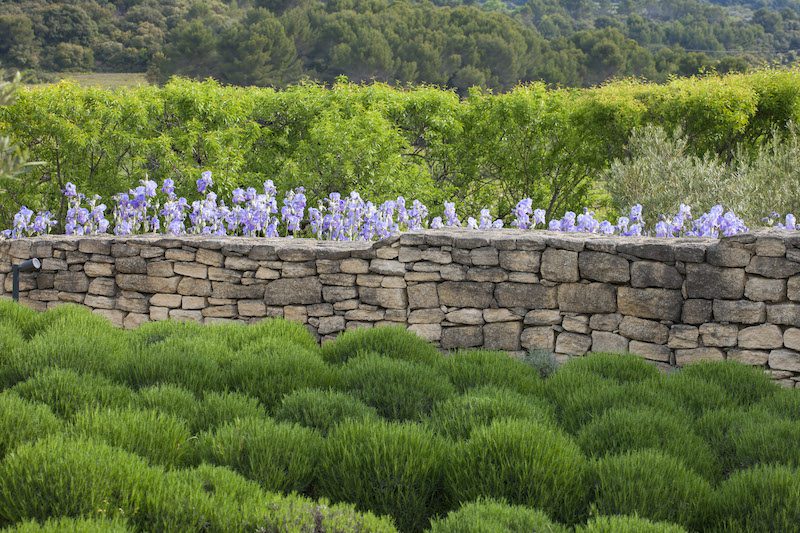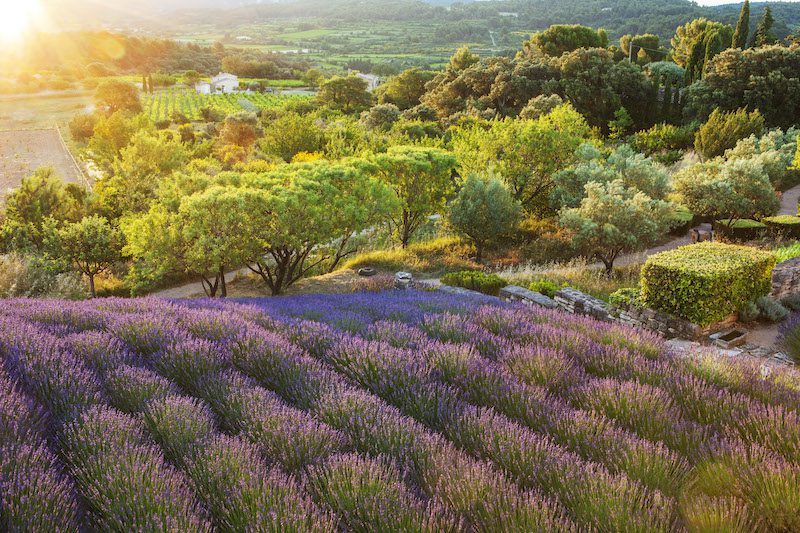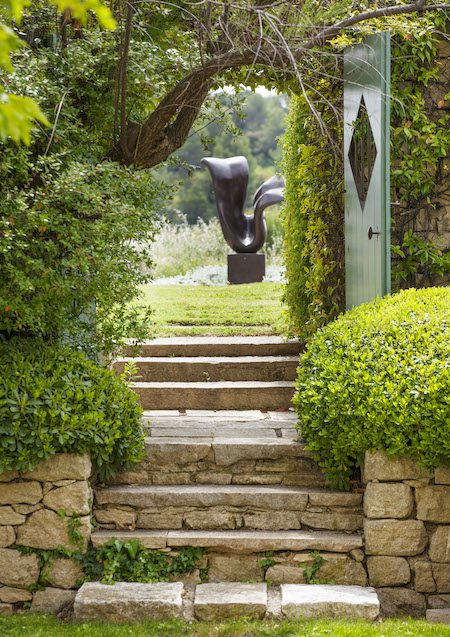Winner of International Design Award for ‘best private garden’ (Torsanlorenzo International design competition 2009), La Jeg is the perfect illustration of how a contemporary garden can seamlessly blend into the natural landscape. A unique backdrop to offset the owner’s extensive sculpture collection…
SUBSCRIBE TO THE MAGAZINE
Situated in the heart of the Vaucluse, La Jeg was the vision of two men. English owner, former photographer and passionate garden sculpture collector, Tony Stone; and award-winning New Zealand garden designer, Anthony Paul. The garden has evolved over several years, planted with now mature and established trees, shrubs and plants indicative of Provence, that effortlessly fuse the garden’s perimeters with the borrowed landscape beyond.
Embracing the landscape
It’s a surprisingly harsh environment. “I was probably crazy to want to make a garden here!” chuckles Tony, who spent many a summer exploring the back roads of this less populated part of Provence, before actually moving to the area.
In 1999 he sold his photo library, Tony Stone Images, to Getty, took early retirement and together with his late wife, bought La Jeg, an old apricot farm set on a hilltop near the picturesque village of La Barroux. Captivated by the property’s magnificent views eastwards to Mont Ventoux, one of the Tour de France’s most gruelling climbs; and northwest to the small mountainous chain, the Dentelles de Montmirail, Tony was sold.

He was eager to embrace the remarkable vistas and outlying natural landscape in La Jeg’s garden design. The indigenous planting is indicative of the region’s harsh environment, only the hardiest plants are able to withstand the arid Mistral and Sirocco winds which blast the property and scorch the stone-riddled earth. Soaring summer temperatures reach 40°C (104°F) and plummet to -10°C (14°F) in winter. Anthony Paul quips that “there was no room in this harsh climate for sissy English flowers!”
Local gardener Bruno Collada, who now looks after the garden for Tony, emphasizes that it is not only important to use plants which will tolerate extreme conditions, but also to source them locally, ensuring plants are fully adjusted to their surroundings. The hard landscaping equally reflects the region’s natural abundance of stone and rock. “Working with and connecting to the landscape was essential to fitting the garden into its location,” explains Anthony. “Borrowing the surrounding scenery (and materials) gives the garden presence and adds credibility to the design.”
The immediate undulating terrain deftly conceals most signs of civilisation. “The valley looks almost uninhabited,” muses Tony, utterly seduced by the early morning mist pockets which settle in the landscape’s folds. These enhance the feeling of remoteness, creating a magical atmosphere at both dawn and dusk.
A garden in tune with nature
Tony’s passion for garden sculpture led to a fortuitous meeting which shaped La Jeg’s future. He was a regular visitor to the Hannah Peschar Sculpture Garden in Surrey, England, which exhibits contemporary garden sculptures in a naturalistic woodland setting. It was here Tony met both sculptress Hannah and her husband, garden designer Anthony Paul. The outcome was inevitable, Tony invited Anthony to help him create a unique space in La Jeg’s two-acre garden which would ultimately house his own sculpture collection.
Anthony first considered the hard landscaping elements by using weathered local materials fashioned by local craftsmen. Stonemasons created the traditional dry-stone walls, hewn from the region’s signature white limestone, akin to surviving, ancient Provencal stone shepherd huts. They built stone stacks on wall ends and crafted freestanding stone cairns, sculptures in their own right, which tie the garden to its land. Salvaged paving stones, weathered and worn, together with an ancient fountain and stream add centuries to the garden, belying its 2001 creation. Carefully-selected, natural materials, all with the patina of age, ensure that the contemporary garden remains compatible with the ancient farm dwelling at its center. The garden looks both inwards and outwards, extending beyond its perimeter into the wide open landscape. A mirror-like pool reflects the sky, adding a third dimension to the design.

Read next: a Rose-clad Farmhouse with Charm
Anthony’s planting style brings a contemporary edge to La Jeg. Gnarled old olive trees, imported from neighboring Italy, were planted amidst remnant apricot orchards and stalwart evergreen oaks, adding weight and presence. In sharp contrast, carved cubes of olives give cutting-edge design. The garden is neatly outlined in evergreen with elaeagnus hedges and topiary boxes which are cushioned with bold mass-plantings of purple Lavandula x intermedia ‘Grosso’ mounds of Santolina chamaecyparissus ‘Lemon Queen’ and thick feathered fringes of Cambridge blue Perovskia. Clouds of pink and white flowering cistus, billowing blue irises, and spires of sunshine yellow Phlomis fruticosa bring yet more color and texture to the garden tapestry.

Anthony’s color palette is restrained, predominantly in shades of blue and lemon. This is particularly evident near the house, which is painted pale yellow with turquoise blue shutters. There’s an intimacy in the garden areas immediately surrounding Tony’s home. A small, tranquil walled garden, Jardin de Curé, occupies the western side: a peaceful enclave which rings with water that tumbles from the ancient stone, wall-fountain. A clean-cut stream crosses the stone slabbed courtyard, before settling in a circular reflecting pool nestled at its center. Mounds of vibrant blue Californian lilac, Ceanothis griseus var. horizontalis ‘Yankee point’ decorate the walls, along with the butter-yellow, rambling rose, Rosa banksiae ‘Lutea’. A stone arch leads into the south garden, an enclosed space carpeted in grass and shaded by an ancient fruiting mulberry tree, Morus bombycis. Here the scent of roses, honeysuckle and white jasmine, Trachelospermum jasminoides perfume the air.
In stark contrast, on the eastern side beyond the house, the gardens open up and run away into the countryside, studded with occasional copses and single trees. The garden is at its wildest at the perimeter edges, where tended vegetation seemingly melts away into the landscape.

Set with Sculptures
In 2011 Tony moved the majority of his garden sculpture collection from North London to the now mature garden at La Jeg. Great thought and planning was given to the positioning of each artwork. “It is crucial to give each piece its own space,” explains Tony, “or the garden ends up looking like a gallery” – which was not the desired effect. The garden’s architecture was used to enhance the siting of individual sculptures. An open doorway frames New Lovers by Marzia Colonna, whilst Chris Booth’s stone Silent Columns break the horizontal wall by drawing the eye up and out into the mountainous landscape beyond. Man and Bird, another sculpture by Marzia Colonna, appears to float simultaneously on water and a purple haze of lavender. It’s a dramatic setting, especially at dawn, ingeniously linking the pool and surrounding planting to the slopes of Mont Ventoux in the distance.

Tony rises early to savor such moments, when the gardens are bathed in a magical light. In addition to the prized pieces dotted around, the garden itself is an inspired and imaginative work of art. A perfect example of contemporary garden design, sculpture and borrowed natural landscape working in breathtaking harmony.
This article was originally published in the July/August 2019 edition of My French Country Home.
Photography by Clive Nichols – Text by Jacky Hobbs

